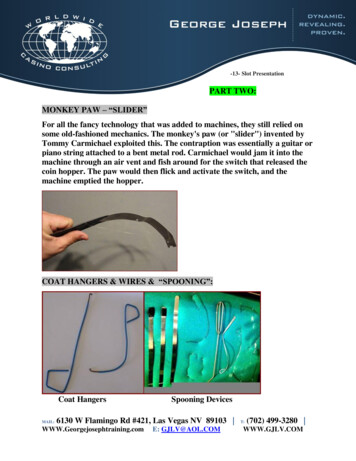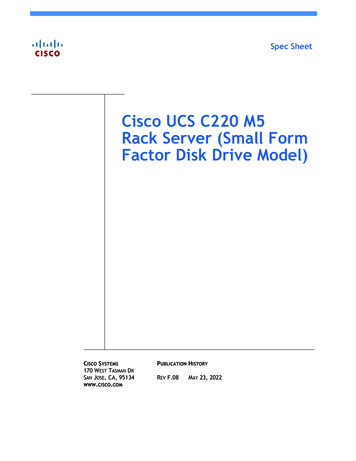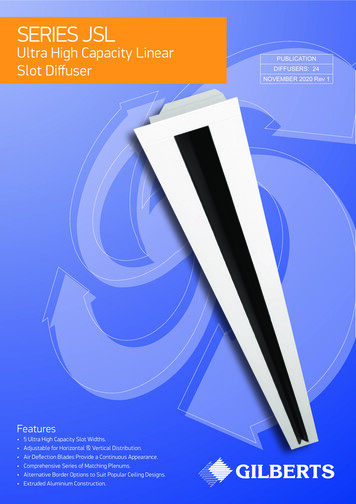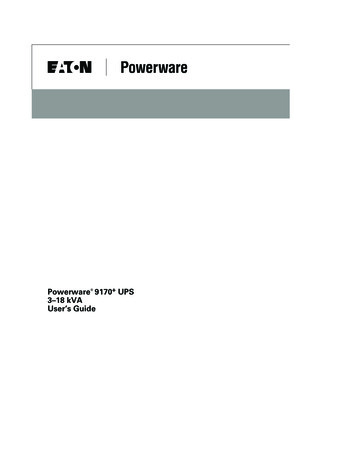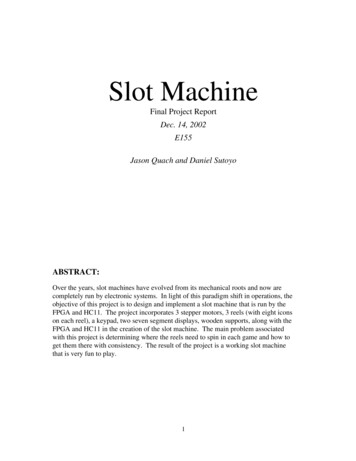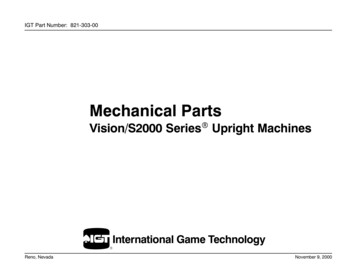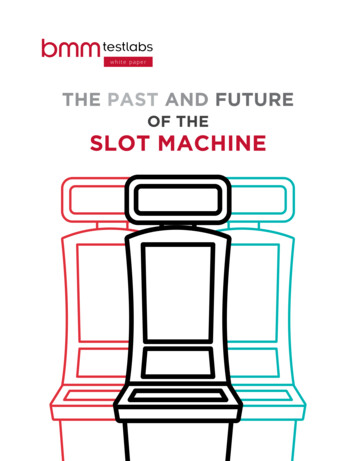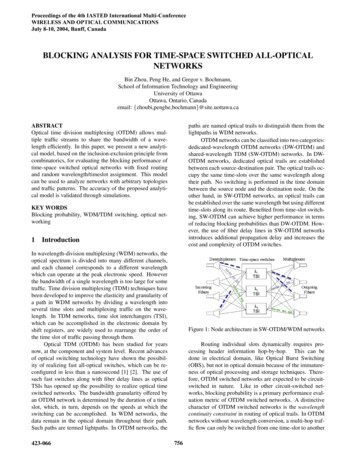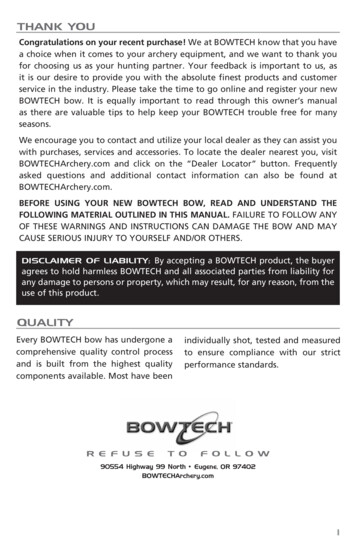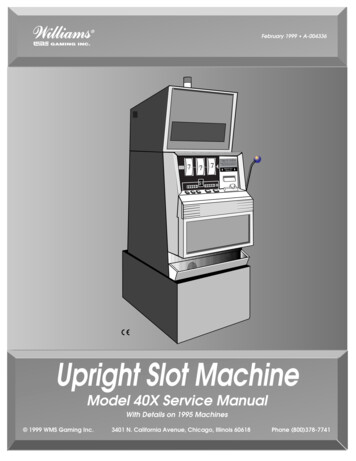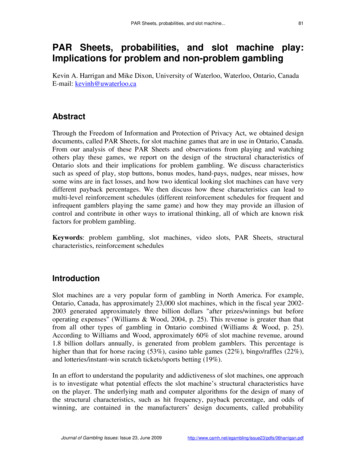
Transcription
PAR Sheets, probabilities, and slot machine.81PAR Sheets, probabilities, and slot machine play:Implications for problem and non-problem gamblingKevin A. Harrigan and Mike Dixon, University of Waterloo, Waterloo, Ontario, CanadaE-mail: kevinh@uwaterloo.caAbstractThrough the Freedom of Information and Protection of Privacy Act, we obtained designdocuments, called PAR Sheets, for slot machine games that are in use in Ontario, Canada.From our analysis of these PAR Sheets and observations from playing and watchingothers play these games, we report on the design of the structural characteristics ofOntario slots and their implications for problem gambling. We discuss characteristicssuch as speed of play, stop buttons, bonus modes, hand-pays, nudges, near misses, howsome wins are in fact losses, and how two identical looking slot machines can have verydifferent payback percentages. We then discuss how these characteristics can lead tomulti-level reinforcement schedules (different reinforcement schedules for frequent andinfrequent gamblers playing the same game) and how they may provide an illusion ofcontrol and contribute in other ways to irrational thinking, all of which are known riskfactors for problem gambling.Keywords: problem gambling, slot machines, video slots, PAR Sheets, structuralcharacteristics, reinforcement schedulesIntroductionSlot machines are a very popular form of gambling in North America. For example,Ontario, Canada, has approximately 23,000 slot machines, which in the fiscal year 20022003 generated approximately three billion dollars "after prizes/winnings but beforeoperating expenses" (Williams & Wood, 2004, p. 25). This revenue is greater than thatfrom all other types of gambling in Ontario combined (Williams & Wood, p. 25).According to Williams and Wood, approximately 60% of slot machine revenue, around1.8 billion dollars annually, is generated from problem gamblers. This percentage ishigher than that for horse racing (53%), casino table games (22%), bingo/raffles (22%),and lotteries/instant-win scratch tickets/sports betting (19%).In an effort to understand the popularity and addictiveness of slot machines, one approachis to investigate what potential effects the slot machine’s structural characteristics haveon the player. The underlying math and computer algorithms for the design of many ofthe structural characteristics, such as hit frequency, payback percentage, and odds ofwinning, are contained in the manufacturers’ design documents, called probabilityJournal of Gambling Issues: Issue 23, June arrigan.pdf
82PAR Sheets, probabilities, and slot machine.accounting reports (PAR Sheets; sometimes called paytable and reel strips [PARS]). Todate, the study of slot machine structural characteristics has been hampered by the factthat researchers have not had access to the manufacturers’ PAR Sheets to see how thegames are designed. We have been successful with requests for PAR Sheets through theFreedom of Information and Protection of Privacy Act (FIPPA, 2007) for four slotmachine games that are approved for use in Ontario.We analyzed the PAR Sheets and played the four games for approximately 60 hr at anOntario casino, Grand River Raceway, which has 200 slot machines. This paper beginswith a detailed description of the structural characteristics of the slot machine games, andthen discusses these characteristics in terms of their potential implications for problemgambling. To our knowledge, this is the first report in problem gambling literature thathas drawn on actual PAR Sheets for games that are approved and being used in a NorthAmerican jurisdiction.The design of slot machine gamesIn response to our FIPPA requests, we were given copies of the following 23 PARSheets, all of which were provided by the North American slot machine manufacturerInternational Game Technology: One version of Double Diamond DeluxeEight versions of The Phantom of the OperaSeven versions of Lucky Larry’s LobstermaniaSeven versions of Money StormDouble Diamond Deluxe and The Phantom of the Opera are traditional mechanical threereel slot machines with physical reels that spin. On both games, the player can see a 3 x 3matrix of symbols, with the middle row being the payline. The player plays the game byusing buttons and/or the handle on the slot machine. Lucky Larry’s Lobstermania andMoney Storm are five-reel video slots games that have a touch screen on which ananimation of five spinning reels is displayed in a 3 x 5 matrix (three rows, five columns).Both video slots games have a bonus mode that a player enters infrequently, but oncethere, the player always experiences frequent wins (from the gambler’s point of view, thebonus mode is a very good place to be). Players play the video slots games by using thetouch screen and/or buttons on the cabinet.Journal of Gambling Issues: Issue 23, June arrigan.pdf
PAR Sheets, probabilities, and slot machine.83Detailed descriptions of PAR Sheets for traditional mechanical three-reel slot machinegames are contained in the gaming industry trade magazine Slot Tech Magazine; thesedescriptions are a useful reference source (Locke, 2001; Wilson, 2003, 2004a, 2004b,2004c, 2004d, 2004e, 2004f). However, they are limited in that (a) the audience for SlotTech Magazine is slot machine technicians and so the articles focus on the practicalissues of how the information contained in PAR Sheets can be used by individuals whoare servicing slot machines, (b) the descriptions cover only traditional mechanical threereel slots, and (c) the descriptions use PAR Sheet examples without indicating whetherthose games are actually used in a specific jurisdiction.Research has been published in the problem gambling literature related to the informationincluded in PAR Sheets for traditional mechanical three-reel slot machine games(Harrigan 2007, 2008, 2009; Turner & Horbay, 2004), but the authors of these papers didnot have access to actual PAR Sheets for games that are approved for use in a NorthAmerican jurisdiction. Also, Griffiths (1993, 1994, 1995, 1999) and Parke and Griffiths(2004, 2006) have written extensively about the structural characteristics of slot machinesin Britain. Although slot machines in Britain are similar to slot machines in NorthAmerica, a significant difference, with respect to the present paper, is that Britishmachines "use a compensator which monitors the payout ratio game by game andinitiates action, as necessary, to influence the random selection of wins and therebyattempt to hold the ratio at all times close to the preselected level" (British patent GB 2165 386A, as cited in Parke & Griffiths, 2006, p. 153), whereas in North America themachines do not have a compensator and the result of every spin is determined by arandom number generator (for a detailed discussion of the differences between Britishand North American machines, see Parke & Griffiths, 2006, pp. 152-153). This paperfocuses specifically on slot machines in Ontario, Canada, as we have obtained PARSheets for Ontario slot machine games.Observations from actual playAs we studied the PAR Sheets, we frequently visited a casino to play, and to watch othersplay, the four games to (a) observe several structural characteristics, focusing on thebonus mode, to ensure that our understanding of the PAR Sheets reflected the way thatslot machines actually behave; and (b) observe several structural characteristics that arenot contained in the PAR Sheets, including speed of play, stop buttons, and "hand-pays."In this section, we provide details on the structural characteristics that we observed.Speed of playWe estimated the speed of play by using the second hand on a watch. On the twotraditional mechanical reel slot machine games, the player can play approximately every6 s, which is approximately 10 spins per minute, or 600 spins per hour. On the two videoslots games, the player can play approximately every 3 s, which is 1,200 spins per hour.Journal of Gambling Issues: Issue 23, June arrigan.pdf
84PAR Sheets, probabilities, and slot machine.Stop buttonsBoth Money Storm and Lobstermania provide two methods to speed up the game byapproximately 50% (i.e., approximately 1.5 s per spin). One method is for the player topress "spin" to begin play, and then press spin again as the reels begin to spin, whichcauses the reels to stop quickly. The second method is for the player to touch one or moreof the reels as they are spinning, which causes the touched reel(s) to stop quickly.Hand-paysAt the casino we frequently visited, the games are configured so that when the outcomeof a spin is a win greater than a certain amount (the amount is 125.00 for Lobstermania),the following occurs: the screen freezes and thus the player cannot play the machinethe light on the top of the machine lights upthe machine makes a sound of a bell ringingan attendant comes by and adjusts the machine to silence the bellthe attendant leavesthe attendant returns with cash and pays the player the winning amount in cashthe attendant makes further adjustments to the machine so that normal play can beresumedCollectively, this procedure is called a "hand-pay." We observed over 20 hand-pays andwe estimate that it takes an average of 5 min from the time the screen freezes until thegame returns to normal play. These five min are usually a very social time during whichfellow players gather and speak to the winning player. The amount required for a handpay varies from game to game and, in general, the amount is higher for games that allowthe player to make higher wagers.Summary of PAR Sheet analysisIn this section, we provide a brief description of various structural characteristics fromthe PAR Sheets, as summarized in Table 1, and then describe several structuralcharacteristics in detail: The first column in Table 1 provides the game name, the number of reels, and thenumber of lines and indicates whether or not there are scatter wins.o The game name is abbreviated: "DD" for Double Diamond Deluxe, "P" forThe Phantom of the Opera, "L" for Lucky Larry’s Lobstermania, and "M"for Money Storm. If there are multiple versions of the game, the gameabbreviation is followed by a number, such as L1, L2, and L3, to indicatethe different versions of Lucky Larry’s Lobstermania.o "Reels" refers to the number of reels, which is three for the mechanicalreel slots and five for the video slots.Journal of Gambling Issues: Issue 23, June arrigan.pdf
PAR Sheets, probabilities, and slot machine. 85o "Lines" refers to the number of lines that can be wagered upon. Themechanical reels slots are single-line games, whereas the video slots aremulti-line games. To illustrate how multiple lines are designed, the top ofFigure 1 shows the 15 lines in Lucky Larry’s Lobstermania. To be a win,identical symbols on a line must start on the leftmost reel and beconsecutive. For example, in Lobstermania a winning combination isthree, four, or five consecutive "BOAT" symbols. The game outcomeBOAT-BOAT-BOAT-CLAM-CLAM is a win, whereas BOAT-BOATCLAM-BOAT-BOAT is a loss, as there are not three consecutive BOATsymbols starting from the left.o On the lower panel of Figure 1, the "S" symbol denotes a "scatter" symbol.Lucky Larry’s Lobstermania and Money Storm afford "scatter" wins. Ascatter win is different from a line win in that scatter wins occur when thescatter symbol occurs three, four, or five times anywhere on the 3 x 5matrix. Figure 1 shows two examples of scatter wins. Scatter wins occurfrequently. As an example, the PAR Sheets show that in one version ofLobstermania, scatter wins account for 25.7% of all wins."Min/max wager" refers to the minimum and maximum bet that a player canwager per spin. Both traditional slots games are "quarter" games and the playercan wager 25, 50, or 75 cents. Both video slots games are "nickel" games and theplayer can wager 5, 10, 15, 20, or 25 cents per line, resulting in a maximum wagerper spin of 3.75 for Lobstermania (25 cents x 15 lines 3.75) and 5.00 forMoney Storm (25 cents x 20 lines 5.00)."Symbols per reel" denotes the number of symbols on each reel. On mechanicalreel slots, this refers to the virtual reels (virtual reels are described later in thispaper). Multiplying the number of symbols on each reel yields the total number ofpossible combinations. For example, Lobstermania’s five reels have 47, 46, 48,50, and 50 symbols, yielding a total of 259,440,000 possible combinations."Payback %" is the payback percentage, which is the percentage of the wager thatthe player will receive back, on average, per spin. Payback percentage is themajor distinguishing characteristic between multiple approved versions of thesame game. Despite the fact that all versions of Lucky Larry’s Lobstermania lookidentical to the gambler, a row of these machines in a casino could contain a rangeof payback percentages varying from a low of 85% to a high of 96.2%."Hit freq" is the hit frequency, or the percentage of times, on average, that theplayer will win something on each line. Table 1 shows that this varies from a lowof 4.9% for the 85% version of Lobstermania to a high of 16.7% for MoneyStorm. The hit frequency does not vary significantly between versions of the sameslot machine game. For example, all versions of Money Storm have a hitfrequency of approximately 16.6%."Plays per jackpot" is the average number of plays before a jackpot is won. Themaximum jackpot can be won only when the player has made the maximumwager on the winning line.Journal of Gambling Issues: Issue 23, June arrigan.pdf
86PAR Sheets, probabilities, and slot machine. "Jackpot amount" is the amount of the highest prize. On the mechanical reel slots,there is a bonus for wagering the maximum number of credits. For example, onThe Phantom of the Opera, a wager of one credit pays a bonus of 1,000 credits,two credits pays 2,000, and three credits pays 5,000. The amount of the jackpotfor both video slots games is linear in that the jackpot is 10,000 times the creditswagered and thus varies from 10,000 to 50,000, as the wager can vary from one tofive credits."Plays per bonus" is the number of plays, on average, before bonus mode isentered. Only video slots have bonus mode, with Money Storm having twobonuses."VI" stands for "volatility index," and is an indication of how much the game’spayback percentage will vary for a given number of games played. Games with ahigh volatility index have a larger variance in the payback percentage pergambling session than do games with a low volatility index. Only the PAR Sheetsfor the mechanical reel slots games include the volatility index. Table 2 describesthe calculation of volatility index and the resulting confidence interval.Multiple approved versions of the same gameAs shown in Table 1, Ontario approves multiple versions of the same slot machine game,with the major difference between versions being the payback percentage. Thedifferences in payback percentages have a direct effect on playing time. In Lobstermania,a player wagering 1.00 per spin would lose, on average, 3.8 cents per spin on the 96.2%game and 15 cents per spin on the 85% game. Thus, the player loses approximately fourtimes more money per spin on the 85% game than on the 96.2% game (15 3.8 3.95).A player arriving with a "bankroll" of 10.00 and wagering 1.00 per spin, who gamblesuntil the bankroll is depleted, would make, on average, 263 one-dollar wagers on the96.2% game ( 10.00 0.038 263), but only 67 one-dollar wagers on the 85% game( 10.00 0.15 66.7); thus a player with a specific bankroll would have approximatelyfour times more gambling time on the 96.2% version versus the 85% version (263 66.7 3.95).Journal of Gambling Issues: Issue 23, June arrigan.pdf
PAR Sheets, probabilities, and slot machine.87Table 1Summary of PAR Sheets for 23 versions of two traditional mechanical reel slot machinegames and two video slots gamesGame /reels xwager ( .05/5.00Symbols perreel (virtualreels for DDand .35.05.04.916.716.716.716.716.716.516.5Plays perjackpotJackpot 010,000-50,00010,000-50,000(credits)Plays /1,429536/1,429536/1,429536/1,429Note. DD Double Diamond Deluxe; freq frequency; L Lucky Larry’sLobstermania; M Money Storm; S scatter wins are available; max maximum; min minimum; n/a not applicable; P The Phantom of the Opera; VI volatility index.Journal of Gambling Issues: Issue 23, June /an/an/an/an/an/an/an/an/an/an/an/an/an/a
88PAR Sheets, probabilities, and slot machine.Figure 1. Line and scatter wins in Lucky Larry’s Lobstermania. The top shows the 15lines and the bottom shows two sample scatter wins, one with three scatter symbols andone with four.Journal of Gambling Issues: Issue 23, June arrigan.pdf
PAR Sheets, probabilities, and slot machine.89Table 2Calculation of volatility index for the 92.5% version of Double Diamond Deluxe, for athree-credit wager of 0.75For each possible win or loss, the casino's profit is recorded in column A. The amount of the win/loss isthen compared with the expected value to determine the variance and standard deviation. The expectedvalue is the Hold.ABCDEFGExpectedA-DE2Max pay Net pay# of 0.92584 0.8571797 0.73472816-118,9600.050797330.07416-1.07416 1.1538197 0.05861115-424,3540.065248840.07416-4.07416 16.59878 1.083051230-97,1980.019284770.07416-9.07416 82.34038 1.587914960-191,5100.004045570.07416 -19.07416 363.82358 1.471872975-243360.000900210.07416 -24.07416 579.56518 0.5217279120-392740.000734100.07416 -39.074161526.79 1.120811150-493620.000969860.07416 -49.07416 2408.2732 2.3356988240-791100.000294710.07416 -79.07416 6252.7228 1.8427413300-991040.000278640.07416 -99.07416 9815.6892 2.7349957480-159800.000214330.07416 -159.07416 25304.588 5.4236515960-319240.000064300.07416 -319.07416 101808.32 6.54631682500-83280.000021430.07416 -832.40749 692902.2314.8513Variance 40.313421Combinations373,248Standard deviation 6.349285Volatility index (z-score for confidence interval) * (standard deviation of the game)z-score for a 90% confidence interval is:1.65Volatility index:10.476 i.e., 6.349285 x 1.65To determine the upper and lower limits for a given number of games:Payback percentage plus/minus (VI/(sqrt(games played)))90% Confidence 0091.5493.6310,000,00092.2592.92Note. max maximum; sqrt square root; VI volatility index.Journal of Gambling Issues: Issue 23, June arrigan.pdf
90PAR Sheets, probabilities, and slot machine.In the games for which we have the PAR Sheets, the different payback percentages of thesame game are achieved by changing the symbols on the reels while maintaining thenumber of symbols per reel. As an example, Table 3 shows the number of occurrences ofeach symbol on the five reels in the 85% and 96% versions of Lobstermania. The numberof occurrences of the highest-paying wild card symbol (WS) and other special symbols(LO and LT) do not vary between versions (2-2-1-4-2, 2-5-6-0-0, and 2-2-2-2-2,respectively). The game designers have manipulated the number of occurrences of allother symbols, such as having 10-3-10-7-8 occurrences of the low-paying SF symbol onthe 85.0% version and only 5-5-6-8-7 on the 96.2% version. The right-hand side of Table3 shows the amount paid for two, three, four, or five occurrences of each symbol.Lobstermania is a nickel slot machine; hence, one credit equals one nickel. As can beseen in Table 3, two WS symbols pay five credits, and five WS symbols pay 10,000credits. All of these payouts are for a wager of one credit on the winning line and aremultiplied by the number of credits wagered. If five credits are wagered, two WSsymbols pay 25 credits and five WS symbols pay the jackpot of 50,000 credits. Becausethis is a five-cent game, the jackpot is 2,500.00 (50,000 x 0.05). As shown in Table 1,one result of this manipulation is that the hit frequency is 5.2% in the 96.2% version andslightly lower at 4.9% in the 85.0% version. Table 4 shows a breakdown of the prizestructure (i.e., the number of occurrences of each winning amount) for three versions ofLobstermania. Most prizes are small, with prizes of two and five credits accounting forapproximately 70% to 75% of all winning hits.Table 3Game designers manipulate the symbols on the reels to achieve different versions of thesame gameLobstermania: Comparison of reels on 85.0% and 96.2% versions.85.0%96.2%Payout (credits)SymbolSymbols per reelSymbols per reel2345WS (wild)2214222142 5 100 500 10,000LM Lobstermania4333444344 240 2001,000BU Buoy3438544545 025 100500BO Boat4343464444 025 100500LH Light House3463754667 01050500TU Tuna4366664567 01050250CL Clam10834766566 0530200SG Sea Gull394 10556566 0530200SF Star Fish103 107855687 0530150LO (bonus)2560025600 0 331 n/an/aLT (scatter)2222222222 0525200Total47 46 48 50 50 47 46 48 50 50Note. n/a not applicable.Journal of Gambling Issues: Issue 23, June arrigan.pdf
PAR Sheets, probabilities, and slot machine.91Table 4The prize structure in the 85.0%, 92.5%, and 96.2% versions of 010,000Total85.0%Hits (%) Pays .450.246.790.042.270.000.15100.00100.0092.5%Hits (%) Pays 0.630.257.120.052.870.000.13100.00100.0096.2%Hits (%) Pays l reel slots: Virtual reel mapping, nudges, and nearmissesVirtual reel mappingThe PAR Sheets show that the two traditional mechanical reel slot machines games usevirtual reels, whereas the two video slots games do not. Physical reels on traditionalmechanical reel slot machines have a limited number of stops, usually 22, which limitsthe number of possible outcomes to 10,648 (22 x 22 x 22 10,648). Double DiamondDeluxe and The Phantom of the Opera use virtual reels, with 72 and 256 stops,respectively, as shown in Table 1, which increases the number of possible outcomes to373,248 and 16,777,216, respectively (723 373,248 and 2563 16,777,216). Table 5shows the mapping of Virtual Reel 1 to Physical Reel 1 for Double Diamond Deluxe: For each spin, the computer generates a random number between 1 and 72, whichcorresponds to a position on the 72-stop virtual reel. Each position on the virtualreel has an equal probability of occurring (i.e., 1 in 72).A weighted mapping is used to map each of the 72 stops on the virtual reel to oneof the 22 stops on the physical reel, which will be on the payline at the end of aspin. As examples, the three Virtual Stops 1 to 3 are mapped to Physical Stop 1,which is a blank; Virtual Stop 4 is mapped to Physical Stop 2, which is the "7"Journal of Gambling Issues: Issue 23, June arrigan.pdf
92PAR Sheets, probabilities, and slot machine. symbol; and the five Virtual Stops 5 to 9 are mapped to Physical Stop 3, which isa blank.Because of the weighting, each stop on the physical reel does not have an equalprobability of occurring on the payline; the blank on Physical Stop 1 occurs on thepayline 3 out of 72 times, the 7 on Physical Stop 2 occurs 1 out of 72 times, andthe blank on Physical Stop 3 occurs 5 out of 72 times.NudgesDouble Diamond Deluxe and The Phantom of the Opera are both "nudging" games. Inthese two games, the reels spin for approximately 5 s and then, 1 s later, one or morereels may nudge up or down. If the reels do nudge, a blank is always nudged away fromthe payline and a paying symbol is nudged to the payline. The design of nudges will beexplained using Table 5: If the virtual stopping position is 10, 11, or 12, then Reel 1 will stop with PhysicalStop 4 (i.e., a One Bar) on the payline and there will be no nudge.If the virtual stopping position is in the range of 13 to 19, then Physical Stop 5(i.e., a blank) will stop on the payline after approximately 5 s.Then 1 s later, the reel will nudge so that Physical Stop 4 (i.e., the One Bar) willbe on the payline.Thus, in this game, the blank in Physical Stop 5 is never on the payline at the endof a spin.The game’s probabilities are not affected by the nudging, as the probabilities arecalculated by using the final stopping position after the nudge.Importantly, not all physical stops containing blanks get nudged off the payline.Some physical stops associated with blanks do appear on the payline, a fact thatcontributes to near misses.Near misses caused by clusteringA near miss is a failure that is close to a win, such as when the high-paying DoubleDiamond symbol appears on the payline on two reels and just above or just below thepayline on the third reel. Wilson (2004a) and Harrigan (2007, 2008, 2009) show in detailhow manufacturers of traditional mechanical reel slot machine games create this type ofnear miss by using virtual reels and a technique called clustering, a technique that is usedin both Double Diamond Deluxe and the Phantom of the Opera. This technique isdescribed briefly here with reference to Table 5: Using the clustering technique, game designers put a high ratio of blanks adjacentto the high-paying symbols in the virtual reel. As an example, the five virtualstops 22 to 26 are mapped to Physical Stop 7, which is a blank; Virtual Stop 27 ismapped to Physical Stop 8, which is the high-paying Double Diamond symbol;and the five Virtual Stops 28 to 32 are mapped to Physical Stop 9, which is ablank.This creates near misses as follows:Journal of Gambling Issues: Issue 23, June arrigan.pdf
PAR Sheets, probabilities, and slot machine.93o Physical Stop 7 (a blank) appears on the payline 5 times out of 72 andwhen it does, Physical Stop 8 will be below the payline. Thus, the DoubleDiamond in Physical Stop 8 will appear below the payline 5 times out of72.o The Double Diamond on Physical Stop 8 will appear on the payline 1 timeout of 72.o Physical Stop 9 (another blank) appears on the payline 5 times out of 72and when it does, Physical Stop 8 will be above the payline. Thus, theDouble Diamond in Physical Stop 8 will appear above the payline 5 timesout of 72.o This clustering technique results in a near miss, in that the player sees thehigh-paying Double Diamond symbol five times more often in the nonwinning position (i.e., above and below the payline) than it appears on thepayline.Table 5Reel 1 of Double Diamond Deluxe: Virtual reel mapping, nudges, and near misses causedby clusteringJournal of Gambling Issues: Issue 23, June arrigan.pdf
94PAR Sheets, probabilities, and slot machine.Near misses caused by asymmetric reelsLobstermania, Money Storm, and The Phantom of the Opera create another form of nearmiss with another technique called asymmetric reels. In this form of near miss, whenthere are several occurrences of a high-paying symbol on one line, it is frequently in nonwinning combinations. As an example, in Lobstermania, the number of lobster symbolsis 2-5-6-0-0 and lobster symbols on Reels 1, 2, and 3 on a played line initiate "LobsterBuoy Bonus." The player sees the lobster symbols 2.5 and 3 times more often on Reels 2and 3 than on Reel 1. The fact that Reel 1 is "starved" of the lobster symbol (yet it isnecessary to get into Lobster Buoy Bonus) elevates the occurrence of near misses (andsimultaneously lowers the number of wins).Near misses caused by wins less than the wagerIn our computer analysis, we were also interested in outcomes in which the win is lessthan the wager, such as when the player wagers 0.75 by wagering 0.05 on each of the15 lines and wins 0.45. The result o
The design of slot machine games In response to our FIPPA requests, we were given copies of the following 23 PAR Sheets, all of which were provided by the North American slot machine manufacturer International Game Technology: One version of Double Diamond Deluxe Eight versions of The Phantom of the Opera
